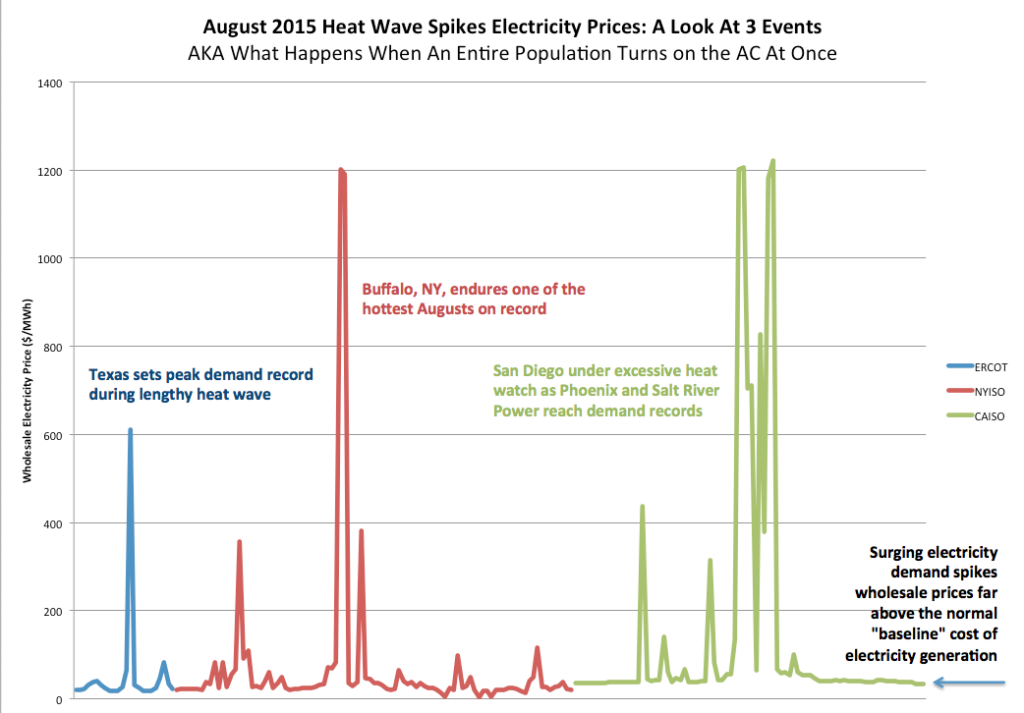
When the Mercury Rises, So Do Electricity Prices. How Demand Flexibility Can Help
The basic law of supply and demand says that as demand surges and/or as supply lags, prices go up. Nowhere have we seen that effect more acutely than with wholesale electricity prices through this exceptionally hot summer in the United States. From the Pacific Northwest to the Southwest to the Midwest to the East Coast, this summer—and especially August last month—was largely known for its widespread scorching heat.
In the Northeast, New York City recorded its third-hottest August on record. At the end of July and into August in the western part of the state, the mayor of Buffalo extended the open hours at the city’s public pools so thousands of residents could escape the stifling heat.
In Texas, a lengthy heat wave with extended triple-digit temperatures saw ERCOT, the state’s grid operator, set a new all-time record for hourly demand (ERCOT actually broke three demand records across two consecutive days in early August).
And in Southern California and Arizona the story was much the same. In early and mid August the region was squarely in Mother Nature’s stiflingly hot crosshairs. Officials issued an excessive heat watch for San Diego County, with temperatures in Borrego Springs forecasted to hit 116 degrees. Meanwhile, that same heat wave saw Phoenix hit its highest electricity demand of the year, while utility Salt River Project on consecutive days set and then broke its own all-time peak demand record.
Of course, all that heat and all the associated electricity demand came largely from one thing: air conditioning (AC). People were using it. A lot.
WHEN RISING TEMPS EQUAL RISING PRICES
As it turned out, when the summer heat kicked in and the AC units turned on, wholesale electricity prices proved the only thing spiking more severely than the mercury. This effect can be seen on any given summer afternoon, when wholesale prices climb above their long-term, off-peak average. But during the three August heat waves in question, the price spikes were especially severe.
Compared to “typical” wholesale electricity prices of $25–60 per megawatt-hour (MWh), in the New York ISO’s western region—including Buffalo—wholesale prices hit $1,100 to $1,200 per MWh. During the ERCOT peak demand record in Texas, the real-time price surpassed $600 per MWh, and a week later as the heat wave continued, the wholesale price was knocking on the door of $900 per MWh. And in the Southern California region of CAISO, where San Diegoans were sweltering, the real-time price broke through $1,200 (see figure below).
For utilities, wholesale price spikes like these are like taking a sucker punch in the gut. They’re paying through the nose during peak on the wholesale market, yet charging customers like you and us a much lower fixed retail price ($/kWh). Meanwhile, “surge pricing” like this is the key revenue source for certain generators that might only run a few dozen hours per year.
CURTAILING DEMAND VS. BUILDING MORE PEAKING PLANTS
Faced with soaring demand—and, potentially, soaring wholesale electricity prices to match—one option has been to simply curtail that demand. That’s the principal behind traditional demand response programs. During a handful of particularly acute grid events each year, such as heat waves just like these, utilities and other grid operators can send a signal to certain participating customers to slash off the top of the demand peak. That’s exactly the idea behind utility Austin Energy’s partnership with Nest, using the smart thermostat to shave some of the AC-induced peak electricity demand for two-hour blocks 10–15 days per summer, and compensating customers for that ability.
Other than curtailing demand, the other option has been on the supply side: build more peaking plants to meet the surging demand. But that’s a costly proposition … both for utilities and their customers and for the planet’s climate. As the wholesale electricity markets demonstrate, they’re a significantly more-expensive source of electricity generation. And peaking plants are much more carbon-intensive than either renewables or traditional baseload generation. Peakers are not a good bet for anyone except those who profit from them, dependent on big electricity demand surges like those in NY, TX, and AZ/CA this summer.
THE IMPORTANT ROLE FOR DEMAND FLEXIBILITY
This is where RMI’s recent report on demand flexibility has an important role to play. Whether you curtail load through demand response or build and call upon peaking plants to ramp up supply, extreme summer peak electricity demand has all been predicated on one fact that has remained largely unavoidable: inelastic demand.
When the mercury climbs, people turn on their AC and the grid cries uncle. Demand response programs have grown up around just these types of acute grid events. But demand flexibility offers a far greater opportunity. With appropriate 24/7/365 price signals from the utility and automated control of certain loads—including the AC via smart thermostats—demand flexibility can take a huge bite out of summer peak demand. Imagine thus lopping off the top of the super-peak wholesale prices utilities pay. Doing so makes the grid lower cost and lower carbon, for the benefit of all.
In the four scenarios we analyzed in The Economics of Demand Flexibility, AC was always either the first or second load called upon, and it always penciled out below the cost-effective break even point. In the case of a hypothetical Salt River Power customer in Arizona, such demand flexibility enabled an average 48 percent reduction in monthly peak demand. Scaled up nationally, demand flexibility among residential customers alone could reduce total U.S. peak demand by 8 percent. Combined with grid-interactive water heaters, AC could thus avoid approximately $9 billion per year in forecasted grid investment.
With a late-summer heat wave currently gripping the East Coast from DC to New York, big numbers like these should be on the minds of customers, utilities, and regulators alike as a way to keep cool and keep demand, grid costs, and customer bills lower, even as the mercury climbs.
Image courtesy of Shutterstock.
